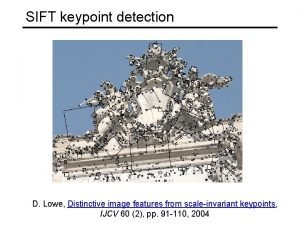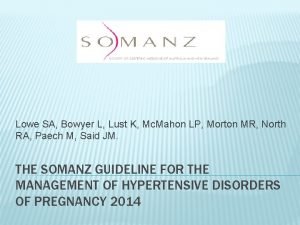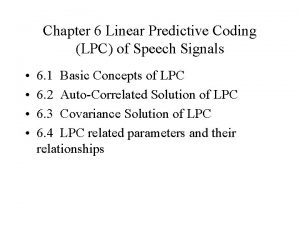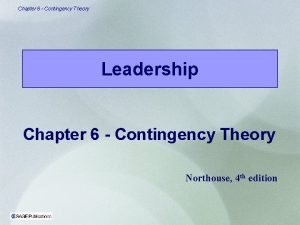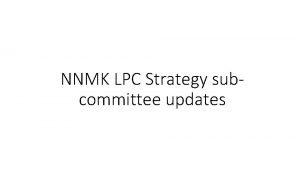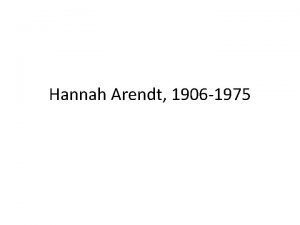Group Leadership Skills HANNAH LOWE M ED LPC























- Slides: 23

Group Leadership Skills HANNAH LOWE, M. ED. , LPC, NCC HLOWE@SHINC. ORG

Tidbits hlowe@shinc. org Introduction to Hannah Lowe Muteof Zoom Dynamics Chat Questions Credit for course 1 hours Group process and techniques

Outline • Skills • Practice (video)

Active Listening • Hearing and understanding both subtle and direct messages and communicating that one is doing this • Am I able to hear both overt and subtle messages? • Do I teach members how to listen and respond?

Reflecting • Capturing the underlying message of what is said or felt and expressing without being mechanical. • Do my restatements add meaning to what is said by a member? • Am I able to reflect both thoughts and feelings?

Clarifying • Focusing on the underlying issues and assisting other to get a clearer picture of what they are thinking and feeling. • a. Do my clarifying remarks help others sort out conflicting feelings? • b. Does my clarification lead to a deeper level of member selfexploration?

Summarizing • Identifying key elements and common themes and providing a picture of the directional trends of a group session. • a. Am I able to tie together several themes in a group session? • b. Do I attend adequately to summarizing at the end of a session?

Facilitating • Helping members to express themselves clearly and to take action in a group. • a. Am I able to help members work through barriers to communication? • b. Am I successful in teaching members to focus on themselves?

Empathizing • Adopting the internal frame of reference of a member. • a. Can I maintain my separate identity at the same time as I empathize with others? • b. Do I promote expressions of empathy among the members?

Interpreting • Explaining the meaning of behavior patterns within some theoretical framework. • a. Do I present my interpretations in the form of hunches? • b. Do I encourage members to provide their own meaning for their behavior?

Questioning • Using questions to stimulate thought and action but avoiding question/answer patterns of interaction between leader and member. • a. Do I ask “what” and “how” questions instead of “why” questions? • b. Do I keep myself hidden through asking questions?

Linking • Promoting member-to-member interaction and facilitating exploration of common themes in a group. • a. Do my interventions enhance interactions between members? • b. Do I foster a norm of member-to-member interactions or leader-to-member interactions?

Confrontation • Challenging members to look at some aspects of their behavior. • a. Do I model caring and respectful confrontation? • b. Am I able to confront specific behaviors without being judgmental?

Supporting • Offering some form of positive reinforcement at appropriate times in such a way that it has a facilitating effect. • a. Do I balance challenge and support? • b. Does my providing support sometimes get in the way of a member’s work?

Blocking • Intervening to stop counterproductive behaviors in the group or to protect members. • a. Am I able to intervene when necessary without attacking a member? • b. Do I block a member’s behavior that is disruptive to the group?

Assessing • Getting a clear sense of members without labeling them. • a. Do I help members to assess their own problematic behavior? • b. Can I create interventions that fit with my assessment?

Modeling • Demonstrating to members desired behaviors that can be practiced both during and between group sessions. • a. Am I able to model effective self-disclosure? • b. Can I model caring confrontations?

Suggesting • Offering information or possibilities for action that can be used • by members in making independent decisions. • a. Do my suggestions encourage members to take initiative? • b. How do I determine when to give suggestions and when to avoid doing so?

Initiating • Demonstrating an active stance in intervening in a group at appropriate times. • a. Do I take active steps to prevent a group from floundering in unproductive ways? • b. Do I teach members how to initiate their own work in the sessions?

Evaluating • Appraising the ongoing group process and the individual and group dynamics. • a. What criteria do * use to assess the progress of my groups? • b. What kinds of questions do I pose to members to help them evaluate their own gains as well as their contributions to the group?

Termination • Creating a climate that encourages members to continue working after sessions. • a. Do I prepare members for termination of a group? • b. Do I help members transfer what they learn in group to daily life?

Practice: Identify the skills you see.

SLC 20 G
 Joining together group theory and group skills
Joining together group theory and group skills David lowe sift
David lowe sift Feature transform
Feature transform Feature transform
Feature transform Sift lowe
Sift lowe Löwe lateinischer name
Löwe lateinischer name Bernie lowe and associates
Bernie lowe and associates Dr robert lowe
Dr robert lowe Procare citrus floor cleaner lowe's
Procare citrus floor cleaner lowe's Susan suchting lowe
Susan suchting lowe Feature transform
Feature transform Jason lowe-power
Jason lowe-power Prof sandra lowe
Prof sandra lowe Lowes founded
Lowes founded Gilly salmon 5 stage model
Gilly salmon 5 stage model Lpc debug port
Lpc debug port Tees lpc
Tees lpc Lpc vocoder
Lpc vocoder Sistem pembayaran gaji
Sistem pembayaran gaji Lpc linear predictive coding
Lpc linear predictive coding Lpc scale contingency theory
Lpc scale contingency theory Lpc 10
Lpc 10 Devon lpc
Devon lpc Lpc matlab code example
Lpc matlab code example




